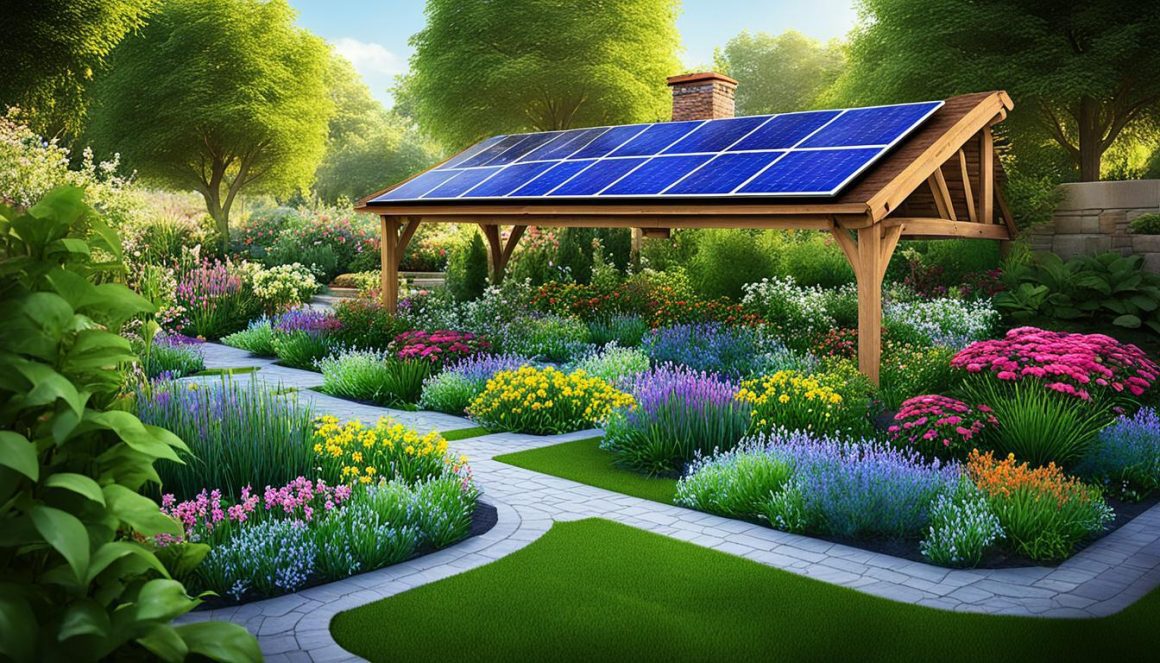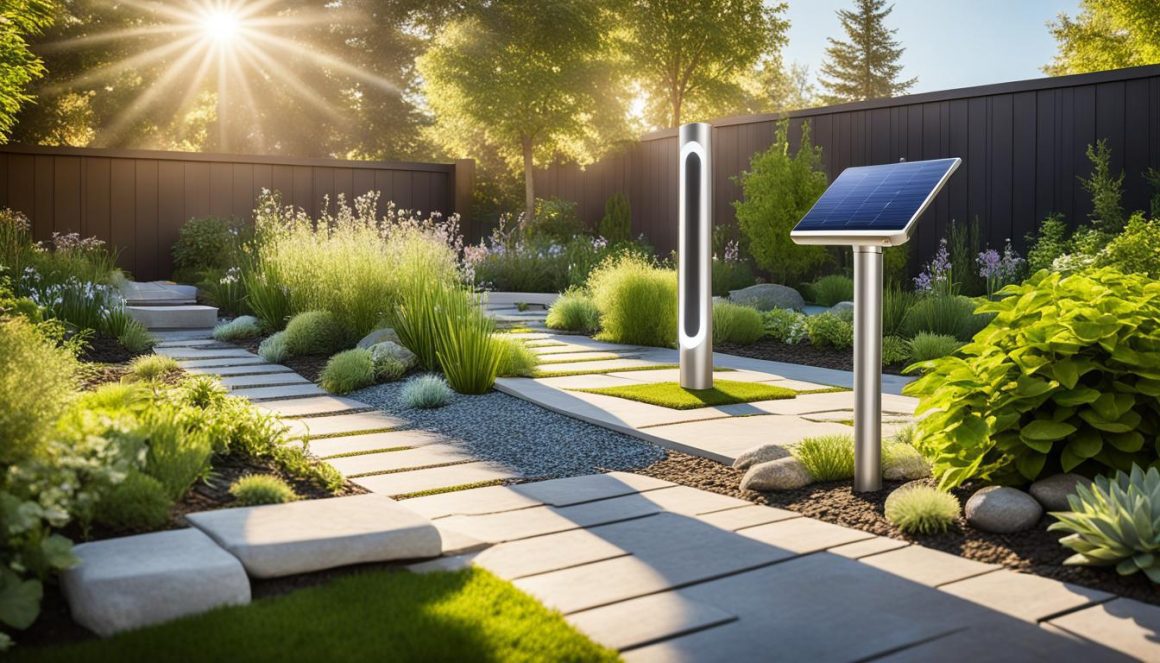Are you looking for innovative ways to transform your yard into an eco-friendly oasis? Imagine a yard that not only promotes sustainable living but also helps you conserve energy and reduce your carbon footprint. Well, it’s time to discover the power of solar-powered smart devices. These cutting-edge upgrades not only improve the functionality of your yard but also contribute to a greener future. So, what are you waiting for? Let’s dive into the world of eco-friendly yard upgrades and embrace the wonders of renewable energy!
Key Takeaways:
- Transform your yard into an eco-friendly oasis with solar-powered smart devices.
- Promote sustainable living and reduce your carbon footprint through energy conservation.
- Discover cost-saving solutions that have a positive environmental impact.
- Embrace the latest green technology to create a beautiful and eco-friendly outdoor space.
- Reduce reliance on traditional energy sources and make a difference in your carbon footprint.
Enhance Your Yard with Organic Mulch and Xeriscaping
When it comes to creating an eco-friendly yard, organic mulch and xeriscaping are two sustainable landscaping practices that can transform your outdoor space. By incorporating these techniques, you not only contribute to a healthier environment but also enjoy the benefits of reduced water usage and weed growth.
Organic mulch made from sustainable materials such as wood chips, shredded bark, straw, leaves, or grass clippings provides numerous advantages for your yard. Firstly, it helps regulate soil temperature, keeping it cooler in hot climates and preventing frost damage in colder regions. Additionally, organic mulch retains moisture, reducing the need for frequent watering. By conserving water, you not only save on utility bills but also promote water conservation.
“Using organic mulch in your yard creates a natural barrier that suppresses weed growth.”
One of the significant perks of using organic mulch is its ability to suppress weed growth. By forming a natural barrier, it prevents sunlight from reaching weed seeds, thus inhibiting their germination. This means less time spent on weeding and the opportunity to reduce or eliminate the use of herbicides. This is not only beneficial for your yard’s aesthetics but also promotes a pesticide-free environment.
Xeriscaping is another sustainable landscaping option that focuses on using drought-resistant plants and minimizing water usage. By selecting plants that are native to your region and naturally adapt to local climates, xeriscaping significantly reduces the need for watering.
- Xeriscaping saves water by as much as 60-70% compared to traditional lawn maintenance.
- Drought-resistant plants require minimal watering once they are established.
- Reduced water usage leads to lower utility bills and supports water conservation efforts.
- By not relying on excess water, xeriscaping helps in the prevention of soil erosion and runoff, further contributing to environmental sustainability.
In addition to conserving water, xeriscaping creates a beautiful and drought-resistant yard that requires minimal maintenance. With the right selection of plants, colors, and textures, you can design an aesthetically pleasing outdoor space that thrives in water-scarce conditions.
| Benefits of Organic Mulch | Benefits of Xeriscaping |
|---|---|
| Regulates soil temperature | Significantly reduces water usage |
| Retains moisture, reducing the need for watering | Minimal maintenance required |
| Suppresses weed growth, eliminating the need for herbicides | Prevents soil erosion and runoff |
| Promotes pesticide-free landscaping | Creates an aesthetically pleasing, drought-resistant yard |
Create a Native Garden and Attract Pollinators
Transform your garden into a vibrant and sustainable oasis by planting a native garden filled with plants and flowers that are native to your region. Not only will this create a stunning visual display, but it also offers a range of environmental perks and benefits.
One of the significant advantages of a native garden is that it saves you money while avoiding the use of harmful chemicals found in some fertilizers. Native plants are naturally adapted to thrive in their specific environment, requiring less water and maintenance compared to non-native species. This helps reduce water usage and conserves valuable resources.
In addition to water conservation, a native garden also plays a crucial role in attracting pollinators such as bees, butterflies, and moths. These pollinators are essential for the reproduction and growth of plants, supporting crop production and biodiversity. By creating a welcoming space for pollinators, you contribute to reducing species decline and promoting a healthy ecosystem.
Furthermore, a native garden can help control pests in a natural and eco-friendly way. Beneficial insects, such as ladybugs and lacewings, are attracted to native plants and act as natural predators, controlling the population of pests like aphids. This eliminates the need for chemical pesticides and fosters a balanced and sustainable garden ecosystem.
When planning your native garden, consider incorporating a variety of native plants and regional flowers. This diversity not only enhances the visual appeal of your garden but also provides essential habitats and food sources for a wide range of beneficial insects and pollinators.
“A garden is a grand teacher. It teaches patience and careful watchfulness; it teaches industry and thrift; above all, it teaches entire trust.” – Gertrude Jekyll
Attracting Pollinators: Plant Selection Guide
To attract pollinators, choose a variety of plants with different bloom times throughout the year. This ensures a continuous supply of nectar and pollen for pollinators. Here are some popular native plants known for attracting pollinators:
| Plant | Bloom Time | Pollinators Attracted |
|---|---|---|
| Black-eyed Susan | Summer to fall | Bees, butterflies |
| Butterfly Weed | Summer | Butterflies |
| Purple Coneflower | Summer | Butterflies, bees, hummingbirds |
| Wild Bergamot | Summer | Bees, butterflies, hummingbirds |
| Joe-Pye Weed | Late summer to fall | Butterflies, bees |
By incorporating these plants into your native garden, you’ll create a haven for pollinators and enjoy the beauty and ecological benefits they bring. Remember to provide shelter, such as trees or shrubs, alongside your flowering plants, as this will encourage a broader range of pollinators to visit.
Embrace the enchanting world of native plants and pollinators by creating a native garden in your yard. Not only will you be rewarded with an attractive and sustainable outdoor space, but you’ll also play a vital role in supporting the environment and encouraging biodiversity.
Grow Your Own Food and Reduce Carbon Emissions
Growing your own fruits and vegetables in a backyard garden is not only a rewarding project but also a sustainable way to reduce carbon emissions. By eliminating the need for transportation and packaging associated with store-bought produce, you can significantly reduce your carbon footprint. Plus, homegrown food doesn’t require the use of fertilizers and chemicals, promoting sustainable and eco-friendly food production.
The Benefits of Having a Backyard Vegetable Garden
Growing your own food in a backyard vegetable garden offers numerous benefits. Firstly, it allows you to enjoy fresh and nutritious produce right at your doorstep. Harvesting your fruits and vegetables when they are ripe ensures that you get the maximum nutritional value.
Additionally, having a backyard vegetable garden reduces your reliance on store-bought produce, which is often transported long distances, contributing to carbon emissions. By growing your own food, you eliminate the need for transportation and packaging, making your carbon footprint smaller.
In a time when sustainability and climate change are critical issues, growing your own food is an impactful way to promote sustainable food production. By not using chemical fertilizers and pesticides, you reduce harmful runoff into waterways and protect soil biodiversity.
Creating a Sustainable and Bountiful Backyard Vegetable Garden
Creating a backyard vegetable garden requires careful planning and consideration. Start by assessing the available space, ensuring it receives ample sunlight throughout the day. Choose vegetables and herbs that are suitable for your climate and growing conditions.
Prepare the soil by adding organic matter such as compost or well-rotted manure to improve its fertility and structure. Mulching the soil with organic materials like straw or wood chips helps retain moisture, reduce weed growth, and promote healthy soil biology.
Regularly water and monitor your vegetables, making sure they are adequately nourished to promote healthy growth. Consider using drip irrigation systems or rain barrels to conserve water and reduce water waste.
Remember to rotate your vegetable crops each season to prevent soil depletion and reduce the risk of pests and diseases. Companion planting can also help deter pests and attract beneficial insects to your garden.
By growing your own food in a backyard vegetable garden, you not only enjoy the freshest produce but also contribute to sustainable food production and carbon emissions reduction.
| Advantages of a Backyard Vegetable Garden | Benefits |
|---|---|
| Fresh Produce | You can harvest fresh and nutritious fruits and vegetables right from your backyard. |
| Reduced Carbon Emissions | By eliminating the need for transportation and packaging, you reduce your carbon footprint. |
| Sustainable Food Production | By avoiding chemical fertilizers and pesticides, you contribute to sustainable agriculture. |
Save Water with Smart Irrigation Systems and Reclaimed Water Solutions
One of the most effective ways to conserve water in your yard is by installing a smart irrigation system. These systems utilize efficient sprinkler heads and advanced weather forecasting features to optimize water usage and avoid wastage. Smart irrigation systems are particularly beneficial in areas with limited water resources, where water conservation is crucial. By incorporating these innovative systems into your yard, you can significantly reduce water usage without sacrificing the health and beauty of your plants.
Another sustainable solution for water conservation is the use of reclaimed water. This involves collecting rainwater through rain barrel systems or drainage systems. The collected water can then be reused for watering your lawn or garden. Rainwater harvesting not only helps you reduce your overall water usage but also adds a unique touch to your outdoor space. It’s an eco-friendly way to make the most of nature’s gift and minimize reliance on conventional water sources.
By implementing smart irrigation systems and reclaimed water solutions, you can play a vital role in water conservation and sustainable living. These practices not only benefit the environment but also contribute to cost savings and promote responsible water usage.


The Benefits of Smart Irrigation Systems:
- Efficient water usage through advanced sprinkler heads
- Weather forecasting features to avoid watering during rain or high humidity
- Customizable watering schedules based on specific plant needs
- Remote access and control via smartphone applications
- Real-time monitoring of water usage and conservation reports
Smart irrigation systems help homeowners reduce their water consumption, lower water bills, and maintain a healthy and vibrant yard.
Rainwater Harvesting and Reclaimed Water:
Rainwater harvesting is a sustainable practice that involves collecting rainwater and reusing it for various purposes. By incorporating rain barrels or drainage systems into your yard, you can capture and store rainwater for future use. This reclaimed water can be used to irrigate your lawn, water your plants, and fulfill other non-potable water needs. Rainwater harvesting reduces dependence on municipal water supplies and minimizes the strain on local water resources.
- Benefits of rainwater harvesting:
- Reduces the demand for treated water
- Financial savings on water bills
- Decreases stormwater runoff and erosion
- Improves soil health and plant growth with natural rainwater
- Reduces the reliance on chemical fertilizers
- Preserves water quality by reducing pollution and runoff
By implementing smart irrigation systems and utilizing reclaimed water, you can make a significant impact in conserving water, reducing water bills, and promoting a greener, more sustainable yard. These eco-friendly practices are not only beneficial for your immediate surroundings but also contribute to a healthier planet for future generations.
Embrace Backyard Composting for Waste Reduction and Soil Enrichment
Transform your backyard into a sustainable haven by embracing backyard composting. This eco-friendly practice not only reduces waste but also enriches the soil, promoting healthier plant growth. By recycling food scraps and yard waste, you can create organic material that nourishes your garden naturally.
Composting eliminates the need for chemical fertilizers, reducing the environmental impact of conventional gardening methods. By incorporating compost into your soil, you improve its structure, enhance water retention, and promote nutrient availability for plants.
One significant benefit of backyard composting is the reduction in methane emissions. When organic waste breaks down in landfills, it produces methane—a potent greenhouse gas. Composting at home eliminates this unnecessary contribution to climate change.
Getting started with backyard composting is easy. You can choose to purchase a compost bin or build one yourself using materials such as wood or wire mesh. It’s essential to maintain a balance between green waste (vegetable scraps, grass clippings) and brown waste (leaves, twigs) to promote the decomposition process.
Remember to turn the compost regularly, keeping it moist but not waterlogged. Avoid adding meat, dairy, or fatty food scraps to prevent attracting pests and rodents.
| Benefits of Backyard Composting: | How to Get Started: |
|---|---|
|
|
The Science Behind Composting
Composting is a natural process where microorganisms break down organic materials into humus-rich compost. These microorganisms consume the organic matter, releasing carbon dioxide and heat as byproducts. The composting process creates an ideal environment for beneficial bacteria, fungi, and insects that further break down the waste.
Composting is nature’s way of recycling and transforming waste into valuable resources.
With backyard composting, not only are you reducing waste and improving your soil, but you are also actively contributing to a more sustainable and environmentally friendly lifestyle. Start composting today and see the positive impact it has on your garden and the planet.
Choose Eco-Friendly Lawn Care Tools and Synthetic Turf
When it comes to maintaining a beautiful yard while reducing your environmental impact, opting for eco-friendly lawn care tools and synthetic turf is a smart choice. By embracing these sustainable alternatives, you can promote eco-conscious living and make a positive impact on the planet.
Electric Lawn Mowers and Battery-Powered Tools
Instead of relying on gas-powered equipment that contributes to air pollution, consider switching to electric lawn mowers, leaf blowers, and battery-powered trimmers. These eco-friendly alternatives not only reduce energy consumption but also eliminate greenhouse gas emissions. Additionally, they operate quietly, reducing noise pollution in your neighborhood.
“Electric lawn mowers and battery-powered tools offer a cleaner, quieter, and more sustainable way to care for your yard.”
Grasscycling for Natural Nutrients
Grasscycling is a simple and effective practice that involves leaving grass clippings on your lawn after mowing. This technique not only saves time and effort but also provides natural nutrients to the soil. Grass clippings break down quickly, returning nitrogen and other essential minerals to the grass. This natural fertilization process results in healthier and greener lawns without the need for synthetic fertilizers.
“Grasscycling helps reduce waste, saves time, and nourishes your lawn naturally without the use of fertilizers.”
Synthetic Turf for Low-Maintenance and Water-Saving Option
Another eco-friendly lawn care solution is synthetic turf, also known as artificial grass or artificial turf. Synthetic turf offers many advantages, including low maintenance and reduced water usage. With synthetic turf, you can eliminate the need for mowing, watering, and fertilizers, making it a more sustainable and cost-effective choice in the long run. It provides a lush and vibrant green space that stays beautiful year-round.
Moreover, synthetic turf is highly durable and can withstand heavy foot traffic, making it ideal for high-use areas such as backyard play spaces or sports fields. It also eliminates the need for harmful pesticides or herbicides, promoting a safer and healthier environment for your family and pets.
“Synthetic turf offers a low-maintenance and water-saving alternative to traditional grass, while still providing a beautiful outdoor space.”
To summarize, choosing eco-friendly lawn care tools like electric mowers, embracing grasscycling, and considering synthetic turf are excellent ways to reduce your carbon footprint and create a sustainable and vibrant yard. By making these environmentally conscious choices, you can enjoy a beautiful lawn while contributing to a greener future.
Incorporate Eco-Friendly Hardscaping and Outdoor Lighting
Create an eco-friendly yard by incorporating hardscaping elements that not only enhance the aesthetics of your outdoor space but also contribute to environmental sustainability. Hardscaping features such as walkways and pavement offer numerous benefits, including reducing water runoff, preventing erosion, and improving soil and vegetation health.
When it comes to choosing the right materials for your hardscape, opt for eco-friendly options that promote sustainability and minimize pollution. Consider irregular stones, recycled asphalt, or permeable pavers, which allow water to infiltrate the ground rather than contributing to water runoff that can lead to pollution and strain local water systems.
Benefits of Eco-Friendly Hardscaping:
- Reduces water runoff
- Prevents soil erosion
- Improves soil and vegetation health
- Minimizes water pollution
In addition to hardscaping, outdoor lighting plays a crucial role in creating a safe and inviting ambiance in your yard. Opt for energy-efficient lighting options that help you save on electricity bills and reduce your carbon footprint.
LED lights are an excellent choice for outdoor lighting due to their energy efficiency and longevity. They consume less energy, last longer, and are more durable than traditional lighting options. Additionally, consider incorporating motion detectors to further optimize energy consumption by only activating the lights when needed.
Solar lights are another eco-friendly lighting option that harnesses the power of the sun to illuminate your outdoor space. They require no electricity, relying solely on solar energy to charge their batteries. Solar lights are easy to install and provide a cost-effective and environmentally friendly solution for outdoor lighting.
Benefits of Eco-Friendly Outdoor Lighting:
- Energy-efficient
- Long-lasting
- No electricity consumption
- Cost-effective
By incorporating eco-friendly hardscaping elements and energy-efficient outdoor lighting in your yard, you can transform your outdoor space into an environmentally friendly oasis while enjoying the many benefits these sustainable upgrades offer.
Harness the Power of Solar Energy with Solar Panels
Did you know that solar panels can help you harness the power of renewable energy while reducing your energy bills? Installing solar panels on your home allows you to generate clean electricity directly from the sun, contributing to a more sustainable and eco-friendly lifestyle.
The benefits of solar power generation extend beyond sunny days. Even on cloudy days, solar panels continue to generate power, providing a reliable source of energy and reducing your dependency on fossil fuels. By utilizing solar energy, you can lower your carbon footprint and contribute to a greener future.
Another advantage of investing in solar panels is the potential for a tax credit. Many governments offer tax incentives to homeowners who adopt solar energy solutions, making it a cost-effective upgrade for your home. Take advantage of these tax credits to further reduce the cost of installing solar panels.
Incorporating solar panels into your home not only saves you money on your energy bills but also supports the transition to cleaner and more sustainable energy sources. With the growing emphasis on renewable energy, solar panels are a wise investment that benefits both the environment and your wallet.
Choose Sustainable Outdoor Furniture and Materials for Deck Building
Furnish your outdoor space with sustainable furniture made from organic materials like bamboo, organic cotton, and sustainable woods. These options are environmentally friendly and promote the use of renewable resources. By choosing sustainable outdoor furniture, you not only create a stylish and comfortable outdoor living area but also contribute to the protection of our planet.
Sustainable bamboo furniture is an excellent choice for outdoor use. Bamboo is a fast-growing and renewable material that is highly durable and resistant to weather conditions. Its natural beauty adds an elegant touch to any outdoor setting. Another option for sustainable outdoor furniture is organic cotton. Organic cotton is grown without the use of harmful pesticides and chemical fertilizers, making it a safe and eco-friendly choice.
When it comes to deck building, opting for sustainable woods is crucial. Look for wood that is certified by organizations like the Forest Stewardship Council (FSC), ensuring it comes from responsibly managed forests. Examples of sustainable woods include teak, cedar, and redwood. These materials are known for their durability and resistance to rot, making them ideal choices for long-lasting and eco-friendly decks.
Avoiding composite decking, which is often made from nonrenewable resources like plastic and can release harmful chemicals during production and disposal, is another way to align your deck building with eco-friendly principles. Instead, consider using natural materials like cedar, bamboo, or redwood for deck building. These materials are biodegradable, more durable than composite decking, and offer a timeless and classic look to your outdoor space.
By choosing sustainable outdoor furniture and materials for deck building, you can create a comfortable and cozy yard while reducing your environmental impact. Embrace eco-friendly options that prioritize the use of renewable resources, and enjoy a beautiful outdoor space knowing that you are making a positive contribution to a more sustainable future.


| Material | Benefits |
|---|---|
| Bamboo | – Fast-growing and renewable – Highly durable and weather-resistant – Natural and elegant look |
| Organic Cotton | – Grown without harmful pesticides and fertilizers – Environmentally safe and sustainable |
| Sustainable Woods (e.g., teak, cedar, redwood) | – Certified by organizations like FSC – Responsibly managed forests – Durable and resistant to rot |
| Composite Decking | – Often made from nonrenewable resources – Can release harmful chemicals during production and disposal |
| Natural Materials (e.g., cedar, bamboo, redwood) | – Biodegradable and eco-friendly – More durable than composite decking – Timeless and classic look |
Conclusion
By embracing sustainable living and eco-friendly yard upgrades, you can make a positive impact on the environment while enhancing your outdoor space. Implementing solar-powered smart devices, organic mulch and xeriscaping, native gardens, backyard composting, and other eco-friendly solutions can significantly reduce your carbon footprint and promote energy conservation.
Not only do these upgrades contribute to sustainable living, but they also offer tangible benefits such as cost-savings on energy bills and the creation of a beautiful and eco-friendly oasis. With renewable energy, water conservation, and the use of sustainable materials, you can transform your yard into a greener and more sustainable space.
Take the step towards sustainable living by incorporating these eco-friendly yard upgrades into your outdoor space. Not only will you be making a positive change for the environment, but you will also be creating a more sustainable future for yourself and future generations to come.

